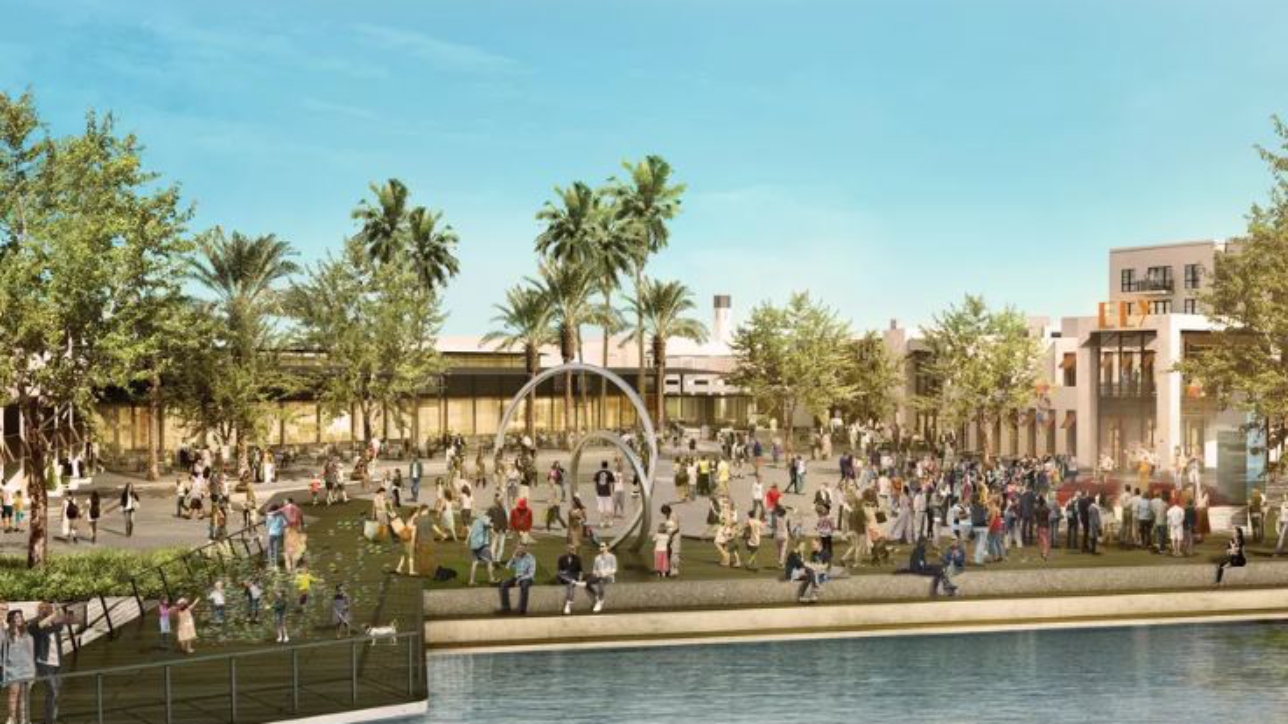Renderings courtesy of Hollywood Park
Southern California is a hot spot for sports-anchored developments.
In recent months, the Los Angeles Football Club’s $350 million soccer stadium in Exposition Park opened, offering food options, conference space and nearby amenities. Meanwhile, in Inglewood, a $4.9-billion stadium is being built on the site of the former Hollywood Park racetrack. The stadium will be home to the Los Angeles Rams and Los Angeles Chargers American football teams, and will anchor a 298-acre mixed-use development, complete with 2,500 housing units, 620,000 square feet of retail space, a 300-room hotel and revamped casino.
The City of Champions Revitalization Project, as the Inglewood development is called, is a resurgence project for Inglewood. Furthermore, it’s part of a national trend of sports-anchored, mixed-use developments. Because the concept is new, evidence as to its success is anecdotal. However, compared to the idea that sports venues, alone, can be economic catalysts, sports-anchored developments might stand a decent chance of success.
The Concept
Economists have soured on the idea that a stand-alone sporting facility, rising amid acres of parking lots, can spur economic development. A Cato Institute report, in fact, indicated that “professional sports generally have little, if any, positive effect on a city’s economy.” The main reason for the lackluster performance is because sports are a part-time business. People have little incentive to spend money at nearby retail or restaurants if the local team isn’t playing.
Still, Newmark Knight Frank research director Marianne Skorupski said: “Once completed, new stadiums attract tens of thousands of people per event over a decades-long span.” This, in turn, is leading to the concept of “downtowns . . . being remade as developers . . . combine new sports arenas with mixed-use residential, retail and office space . . . surrounding them not with mostly idle parking lots . . . but with revenue-producing stores, offices and residences capable of servicing the public debt used to help build those venues,” according to the New York Times.
The Advantages
Though sports-anchored developments are in their infancy, Inglewood developers can take comfort from a mixed-use project to the north. Specifically, Golden 1 Center, an arena housing the Sacramento Kings basketball organization. The downtown Sacramento stadium opened in 2016, and anchors the mixed-use Downtown Commons (DoCo).
Though DoCo is under construction, the Downtown Sacramento Partnership released glowing statistics about the impact of Golden 1 Center on the CBD. Specifically:
- Employment increased by 38% since arena construction began, and nearby office vacancies dropped to a five-year low of 8.2%
- Downtown pedestrian traffic increased 10% between 2016-2017 (the latest figures available)
The above are metrics that the Hollywood Park developers, led by the Kroenke Group, can take comfort from
The Concerns
The above is not to suggest that sports-anchored arenas are automatic slam dunks. Robin Hunden with Hunden Strategic Partners, which specializes in destination development, said such projects should be placed near urban environments, in which infrastructure and density are already in place. Venue success is also based on available transportation to provide easy access for fans, consumers and tourists. Golden 1 Center is in downtown Sacramento, near plenty of density — and public transportation.
Nor would this be a problem for Inglewood, which is situated near two major freeways, and which will benefit from the Crenshaw-LAX rail line, scheduled for a late 2019 opening. The line will connect Inglewood with downtown Los Angeles and the airport.
But, NKF’s Skorupski reminds us that such projects require a great deal of time and labor, meaning that resources are limited for other developments — such as affordable housing.
Speaking of which, gentrification is an issue, especially in a region already experiencing a severe lack of affordable housing. Sixty-five percent of the Inglewood population are renters, with 56% spending at least 30% of income on housing costs and nearly one-third allotting 50% or more of their take-home pay to rent or mortgage. Residents in Inglewood are already experiencing increased property values and rents. Displacement of long-time residents could be a downside to the revitalization project.
If You Build It . . .?
The City of Champions Revitalization Project is estimated to create thousands of construction jobs, and thousands more jobs when the project is completed. It could also deliver $25 million in permanent annual tax revenue to Inglewood, while special events, such as Super Bowls and Final Fours could bring additional dollars to the region. On the downside, it could also drive out long-time residents.
West Virginia Professor of Economics Brad Humphreys acknowledged that: “it’s going to take 10 more years before we can get a good assessment” on the success, or failure, of sports/mixed-use projects. While it’s too soon to tell how the new Hollywood Park will impact Inglewood, anecdotal evidence suggests it could succeed in bringing the city back to its glory days.

